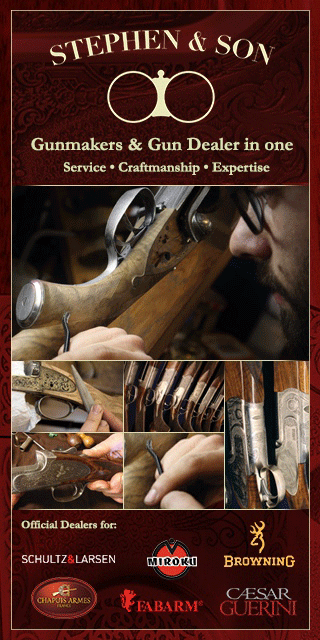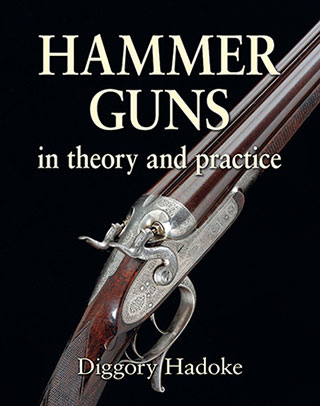Taking a Gun from the UK Overseas.
If you wish to take firearms or shot guns to another EC country you require a European Firearms Pass.
The pass lists both firearms and shotguns and can be obtained by writing to your local Police at their Firearms and Explosives Licensing section. It is free, no photographs are required and is valid until whichever certificate expires first.
Legal Issues Relating to Sporting Guns
The shooter in the UK needs to be aware of the main laws that govern our sport and the guns and rifles with which we pursue it. In Britain, the types of firearm that we commonly come into contact with can be split into the following sections (arranged in order of ease of ownership):
Air Weapons
Air rifles with a power output of less than 12ft/lb are available to shooters without the need for a licence. For air pistols, the power limit is reduced to 6ft/lb. On no account should owners try to improve the power output of an air weapon because if they exceed these limits, they are considered ‘Section 1’ firearms.
There is no security requirement for air weapons but owners are advised to store them securely so that they may not be stolen or misused by another person.
To use an air-rifle or air-pistol on enclosed private land a person must have the requisite permission and must be legally old enough. It is an offence for a person under 17 years old to be in possession of an air weapon, or ammunition for it, except:
a. As a member of an approved club for target shooting.
b. Whilst at a shooting gallery where only air weapons or miniature rifles not exceeding .23 calibre are used.
c. Whilst under the supervision of a person aged 21 years or over, or whilst shooting, on private premises, including land, provided the missile is not fired beyond those premises.
d. From the age of 14 years old, whilst on private premises with the consent of the owner. No supervision is required.
‘Section 58’ Antique Weapons
The Home Office has a list of ‘Obsolete Calibre’ rifles, shotguns and pistols. These may be bought, sold and possessed without a licence of any kind, provided that they are owned as curios only. These weapons may not be fired and to possess ammunition for them is likely to invalidate any claim that they are not for use. No ammunition is considered ‘obsolete’.
Among the ‘obsolete calibres’ we find vintage pin-fires, muzzle-loaders, rim-fires (not including .22 and .9mm) and large bore shotguns like 4-bore and 8-bore. The rules only apply to pre-1939 manufactured weapons (so a 1995 Pedersoli 12-bore muzzle-loader is not considered ‘obsolete’ under Section 58 but an 1840 Manton is).
Pre 1939 rifles, shotguns and punt guns chambered for the following cartridges: 32-bore 24-bore, 14-bore, 10- bore (2 5/8″ and 2 7/8″ chambers only), 8-bore, 4-bore, 3-bore, 2-bore, 1 1/8 bore, 1 ¼ bore and 1 ½ bore, are all considered ‘obsolete’. For a full list of every rifle and pistol calibre considered ‘Obsolete’ under UK law click this link:http://www.david-squires.org.uk/Antiques.htm
Any weapons listed on the ‘Obsolete Calibre’ list may be hung on the wall or form part of a display, as there are no security requirements. It is important to stress that any attempt to fire a Section 58 weapon is an extremely serious offence, which could lead to a prison sentence.
‘Section 2’ Shotguns
Most shooters do most of their shooting in the UK with a shotgun. The law defines this as a smooth-bored gun with barrels of not less than 24”. If the gun is a semi-automatic or pump-action, the magazine must be restricted to hold no more than two shells, with a third in the chamber. This is quite confusing these days because some modern wildfowling magnums are chambered for 3 ½” shells. This makes it possible to load more than the legal maximum number of shells into the gun if you use 65mm cases. Readers are strongly advised not to do so because the police may construe your shotgun as a ‘de facto’ Section 1 firearm if it is used in this way.
To buy, sell or possess a ‘Section 2’ shotgun you are required to hold a valid Shotgun Certificate. You can see the form you need on the Metropolitan Police website:http://www.met.police.uk/firearms-enquiries/pdfs/FF103.pdf . This can be applied for through your local police station and is issued by your constabulary. They will ask you to complete a form and provide photographs and pay a fee. They will visit you and check your security before deciding if they will issue you a Shotgun Certificate. It is the right of every citizen to have a Shotgun Certificate granted unless the chief police officer believes there are grounds to stop you from having one. He must make these grounds clear in the case of a refusal. A past conviction for a serious crime may be one such reason.
The security requirement for shotguns is quite stringent. The police will inspect yours and advise you on their requirements. The law says you must secure your guns from theft. This usually means you will need to lock them in a steel cabinet of police-approved design and quality. Try www.safesecurityservices.co.uk to see examples. The cabinet must be secured to a supporting wall by means of coach bolts and be flush with the wall to prevent it being prized away. A SGC holder may have as many shotguns as he wishes, providing he can secure them to the police’s satisfaction.
Each shotgun must be entered on the SGC and the police must be informed of each purchase and disposal. A SGC holder may borrow a shotgun from another SGC holder for 72 hours without informing the police.
Some forces advise shotgun owners to have a monitored alarm so that the police are automatically informed if your house is broken into. These cost around £400 for installation and incur a monthly service charge of around £14. See www.its-home-security.co.uk for examples of services and prices.
When travelling with shotguns, try not to leave them unattended in a vehicle. They should be stowed out of sight and the fore-ends should be removed to render them useless should they be stolen. Trigger locks or cable ties are also a wise precaution.
‘Section 1’ Firearms
Shooters wishing to use a .22 for rabbiting, a .17HMR for vermin control, a .243 for foxing or a .308 for stalking will need a ‘Section 1’ Firearms Certificate. This enables the holder to possess the exact calibre, number and type of rifles specified on the licence and outlines the purposes for which each may be used. Therefore, if you are found shooting rabbits with your .308 and it specifies on your licence that it is for deer shooting, you will be committing an offence. You can see the application form for a FAC on the Metropolitan Police website: http://www.met.police.uk/firearms-enquiries/pdfs/FF101.pdf
Unlike ‘Section 2’ shotguns, a ‘Section 1’ firearm must be required for a specific purpose (called ‘Good Reason’) and the police need to be satisfied that the applicant needs it and has good cause to want it for the specified purpose. If you cannot convince the police of your need, they do not have to grant the FAC.
A first FAC is usually restricted and the owner may only use his rifle on land specified or approved by the police for that calibre weapon. An experienced FAC holder may be granted an ‘open licence’ which means he can use the rifle anywhere he judges it to be safe and appropriate, within the law.
Another type of gun that is considered a ‘Section 1’ firearm is any shotgun with a barrel shorter than 24” or a semi-auto or pump-action gun with the capacity to hold more than two shells in the magazine, or any shotgun with a detachable magazine. Air rifles which exceed the 12ft/lb power output limit are considered ‘Section 1’ firearms.
Security for ‘Section 1’ firearms is similar to that for shotguns except that the police are more likely to insist on a monitored alarm and they also require ammunition to be locked securely (ideally in a separate section from the rifles).
In order to buy and sell ‘Section 1’ firearms, the police must grant permission in advance for each sale or transfer. Any ammunition purchased must be entered on the FAC by the seller and the amount of ammunition possessed is restricted and specified by the police.
When travelling with firearms, do not leave them unattended and whilst travelling, bolts, magazines and ammunition should be stowed separately from the rifle. Trigger locks and cable ties are also a wise precaution.
‘Section 5’ Prohibited Weapons
‘Section 5’ covers weapons that are prohibited unless special permission is granted by the Home Secretary. This section covers automatic weapons, military weapons and modern handguns. Specialist collectors and dealers are able to gain Section 5 authority but is will not be available to the vast majority of shooters and collectors.
Worried or Unsure?
If in any doubt about your legal status, please contact you local police, check the Metropolitan Police website (which is very helpful and easy to follow) or talk to a Registered Firearms Dealer.
If you find a gun in your attic or if a relative dies and you find yourself in possession of a weapon for which you are unsure you have the required authority to possess, the law allows for you to hand it to a Registered Firearms Dealer. He will ask for your name but you are not obliged to provide it. He will then inform the police that a firearm has been handed-in anonymously and they will check that it has not been used in crime and then authorise the RFD to dispose of it legally.
The police would rather unlicensed guns be ‘in the system’ and they will not seek to penalise the honest hand-over of firearms that are currently unlicensed. If in doubt, you can contact us for one of our experts to advise you.
Published by Vintage Guns Ltd on (modified )



